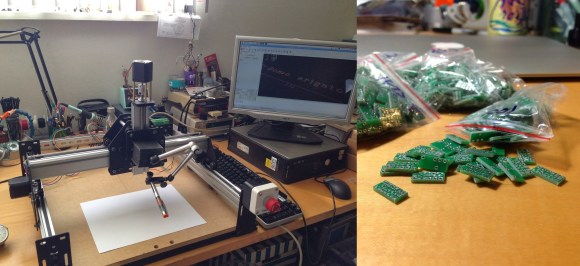
[Pete’s] invented a product called an AIR Patch Cable designed to interface with an airplane’s intercom, and is looking to manufacture and assemble them himself — unfortunately, the circuit boards are tiny, and SMD components aren’t exactly the easiest to install. So he decided to build a pick and place machine to do it for him!
It’s not finished yet, but [Pete] has reached a major milestone — he’s finished the base CNC machine aspect of it. He opted for a kit build for the major mechanical components, the Shapeoko 2 — its a solid design and if you decided to make something from scratch it’d probably cost much more and take a lot longer.
From there he began selecting his electronics individually. He’s chosen the Big Easy Driver by Sparkfun to control his stepper motors, which supports a maximum size of NEMA 17 steppers, so he bought five of those too. To control it all, he’s using LinuxCNC which is an excellent choice — and if you’re not crazy about Linux, you can actually download Ubuntu 10.04 with LinuxCNC pre-installed for you to make it super easy — you’ll just need an old dedicated PC to use.
Once everything was setup, he wrote a quick program to control his future pick and place machine — he strapped a pen onto the Z-axis and it scratched out its first word: “Gangsta”. Cause you know, G-Code. Right? Yeah. Anyway, we’re quite excited to see how this progresses.
To see a pick & place machine that’s already functioning, check out this beautiful piece of work!















The next step will obviously be to manufacture and assemble his new line of hobbyist pick-n-place machines himself…
I was just thinking to myself “when he finishes, I’m gonna ask him for one’
Not to sound cynical, but all I see here is an assembled stock shapeoko 2. This project is about 2% finished.
He should have made the circuit boards into a panel instead of cutting them up into tiny pieces.
The Nema system just tells you about the casing dimensions, nothing about the actual motor. The Big Easy Driver can output up to 2 amps so it’ll happily drive any motor that can run on (up to) 2 amps. I have some Nema 23 steppers that are rated for 1.5 amps, but according to your article I can’t use them with a Big Easy Driver. I hope no one tells the motors!
All I see is an X/Y gantry. Without feeders, it’s not a useable pick & place machine
Also needs cameras and machine vision software. Still a lot to do :) And seeing that the boards only have 3 SMD components on them, you could make 1000 boards in a day by hand.
Vision isn’t necessary for basic Pick and Place, see the chinese TM220A machine
http://www.youtube.com/watch?v=yRxcYO0nuD8
no vision system, but works quite well.
I thought about buying a Shapeoko 2 for a pick & place, but I was well aware that it would still have been a major project once the Shapeoko 2 was built.
I’ll keep an eye on the project.
It’s a good idea. You’ll find, though, that the there are a lot of very devilish details. Picking up small parts reliably is hard. Feeding parts from reels is hard. You can get very far by using computer vision … but then CV can be quite advanced.
Then there’s set-up. If it’s just going to be G-code driven, fine, someone can sit down and write the G-code. But if you want to have libraries of feeders, parsers for Eagle boards, paste dispensing, etc, you’ll find out there is a *tremendous* amount of software to write.
These guy are doing a good job of it, but I don’t know when they’re going to hit the market: http://tempoautomation.com/
We have a Madell Tech machine here in lab, and jesus, it pretty much requires a full-time person with a B.S. in engineering to get it set up and running, due their heinously complicated design and software.